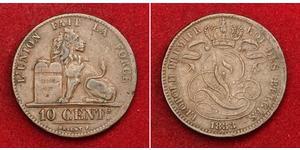(продана за $283.0)
1581, Brunswick-Wolfenbuttel, Julius. Early Silver "Woodwose/Light" Thaler Coin. RR!
Mint year: 1582
Mint Place: Goslar
Mint Master: Hands Kuene (privy mark: doouble-cross).
Reference: Davenport 9063, Welter 576, MB-257. RR!
Denomination: "Light" Thaler ("Lichttaler" in German)
Condition: Lightly cleaned with minor deposits remained, areas of weakness and light planchet striae, otherwise a nice VF-XF for this early issue!
Weight: 29.09gm
Diameter: 40mm
Material: Silver
Obverse: Wildman (woodwose) walking right holding lit candle in right hand, tree trunk in left. Date (I5-8I) in fields.
Legend: ++ * ALIIS * INSERVIENDO * CONSVMOR * ("I exhaust myself in order to give light to others!")
Reverse: Helmeted 4-fold arms with, supported by two half-naked wildmens. Titles of Henry Julius around.
Legend: M . G . IVLIVS . D . G . DVX . BRVN . E . LV . G . V :
For your consideration a rare and early l6th Century Thaler coin from Brunswick-Wolfenbüttel, a very rare example of the so called "Light" thaler type, referring to the obverse scenery of the coin, which shows a wild man (a woodwose), holding a candle-stick. This coin was struck from the silver rich silver mines of the Harz Mountains. A very rare and important addition!
The wild man or woodwose is a mythological figure that appears in the artwork and literature of medieval Europe. Images of wild men appear in the carved and painted roof bosses where intersecting ogee vaults meet in the Canterbury Cathedral, in positions where one is also likely to encounter the vegetal Green Man. The wild man, pilosus or "hairy all over," and often armed with a club, was a link between civilized humans and the dangerous elf-like spirits of natural woodland, such as Puck. The image of the wild man survived to appear as supporter for heraldic coats-of-arms, especially in Germany, well into the 16th century. Early engravers in Germany and Italy were particularly fond of wild men, wild women, and wild families, with examples from Martin Schongauer and Albrecht Dürer among others.
The earliest medieval concepts of the wild man focus on him as a normal human gone wild by madness, as in the Biblical story of Nebuchadnezzar; this first occurs in Celtic societies in the High Middle Ages. These Celtic stories attribute to the wild man poetic or prophetic powers. The 9th-century Irish tale Buile Shuibhne (The Madness of Sweeney) describes how Sweeney, the pagan king of the Dál nAraidi in Ulster, assaults the Christian bishop Ronan Finn and is cursed with madness as a result. He spends many years traveling naked through the woods, where he composes verse. The Welsh told a similar story about Myrddin Wyllt, the origin of the Merlin of later romance. In these stories Myrddin is a warrior in the service of King Gwenddoleu ap Ceidio at the time of the Battle of Arfderydd. When his lord is killed at the battle, Myrddin takes to the Caledonian Forest in a fit of madness which bestows him with the ability to compose prophetic poetry; a number of later prophetic poems are attributed to him. The Life of Saint Kentigern includes almost the same story, though here the madman of Arfderydd is instead called Lailoken, which may be the original name. The fragmentary 16th-century Breton text An Dialog Etre Arzur Roe D'an Bretounet Ha Guynglaff (Dialog Between Arthur and Guynglaff) tells of a meeting between King Arthur and the wild man Guynglaff, who predicts events which will occur down to the 16th century
The Harz is the highest mountain range in northern Germany and its rugged terrain extends across parts of Lower Saxony, Saxony-Anhalt and Thuringia. The name Harz derives from the Middle High German word Hardt or Hart (mountain forest).
The Harz was first mentioned as Hartingowe in an 814 deed by the Carolingian King Louis the Pious. Settlement within the mountains began only 1000 years ago, as in ancient times dense forests made the region almost inaccessible. The suffix -rode (from German: roden, to stub) denotes a place where woodland had been cleared to develop a settlement.
The year 968 saw the discovery of silver deposits near the town of Goslar, and mines became established in the following centuries throughout the mountains. During the Middle Ages, ore from this region was exported along trade routes to far-flung places, such as Mesopotamia. The wealth of the region declined after these mines became exhausted in the early 19th century.
Julius of Brunswick-Lüneburg (also known as Julius of Braunschweig),(29 June 1528, Wolfenbüttel – 3 May 1589, Wolfenbüttel), Duke of Brunswick-Lüneburg, was prince of Wolfenbüttel from 1568 until his death.
The youngest son of Henry V, Duke of Brunswick-Lüneburg, Julius was expected to pursue a clerical career. He studied at Leuven University, and was appointed bishop of Minden in 1553, but resigned after only a year. After both of his brothers died in the Battle of Sievershausen of 1553, he became heir to the principality. All plans of his father's to exclude him from the line of succession failed, even though Julius had converted to Protestantism. After his father's death in 1568, Julius instituted a tax reform that improved the rights of farmers in relation to noblemen. He also founded a militia — every head of household was required to own a weapon and participate in military training — and reformed the court system. Julius entered into an agreement with the City of Brunswick in 1569, in which the city recognized his overlordship; however, the conflict between Duchy and City continued nonetheless.
Julius promoted trade and especially mining. Copper and lead mining in the Harz flourished, and many new mines were opened. Julius himself wrote a book about the uses of marl. To enable the sale of mining products, Julius invested into the improvements of roads and rivers. In 1577 the Oker was made navigable between the Harz and Wolfenbüttel. In 1576, Julius founded the first university of the state, the University of Helmstedt. The university was intended to train Protestant priests for the newly reformed state.
In 1581, he purchased the beautiful Italian palazzo Ca' Vendramin Calergi on the Grand Canal in Venice, one of his favorite cities to visit. He paid 50,000 ducats for the palazzo to the Loredan family, who were having financial difficulties at the time. However, he sold it only two years later to Gugliemo (William) III Gonzaga, Marquis of Mantua.
After the death of Eric II, Duke of Brunswick-Lüneburg, in 1584, Julius inherited the Principality of Calenberg. He died in 1589 and was succeed by his son Henry Julius.

|
Добавив:
anonymous 2015-01-06 |
1/2 Цент Королівство Нідерланди (1815 - ) Мідь Віллем III
в групі 10 монет / 10 цін
⇑
10 Сантім Бельгія Мідь Leopold I of Belgium (1790-1865)
в групі 8 монет / 8 цін
⇑








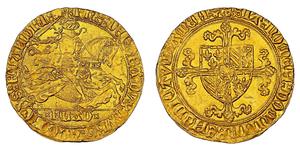

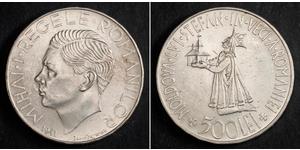
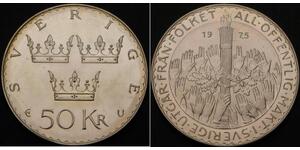
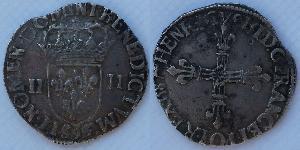


-300-150-ZwusHgTycaAAAAGPadNVj7Mq.jpg)


